Aloe Vera plants are one of the most popular plants found widespread. They are succulents, like cacti, and can tolerate a lot of sunlight. Since they are habituated to growing in deserts under adverse temperature conditions, they can endure direct exposure to sunlight.
Aloe Vera requires 5-6 hours of direct sunlight, so it is ideal to keep them in the southern part of your home. Sufficient light encourages faster growth in these plants, but despite their demand for full sun, they must be protected from the sun’s scorching heat during mid-day.
Since Aloe Vera is famous for its medicinal properties, you might be planning to get one.
And if you don’t understand their lighting needs yet, this guide can help you. Today, I will be addressing the light requirements for an aloe plant.
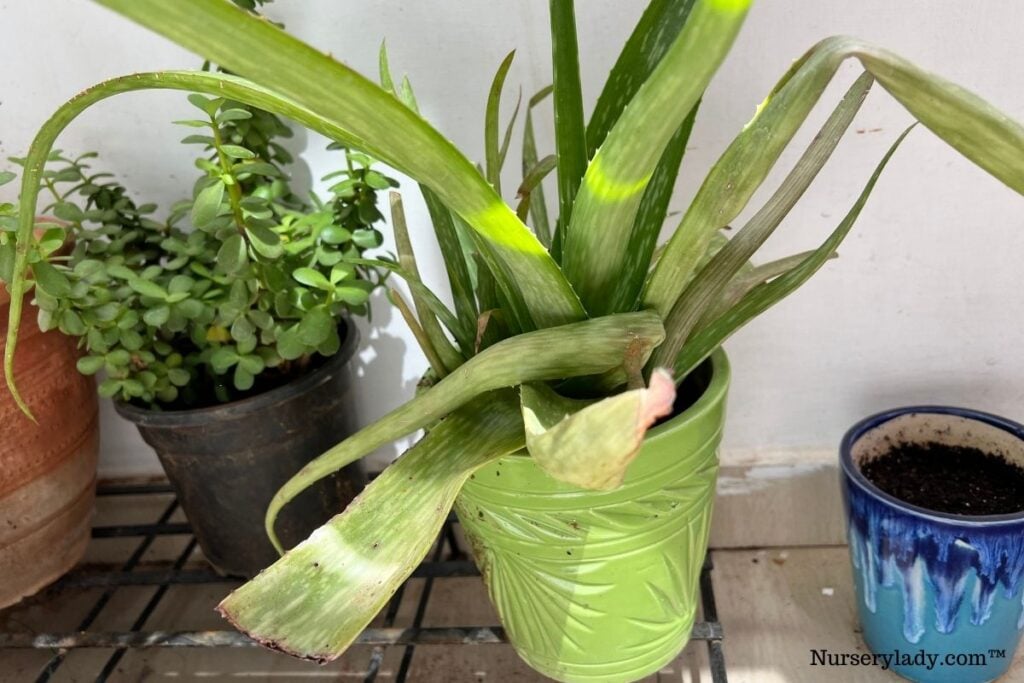
What is the best lighting for an aloe vera plant?
Aloe Vera can grow well under different light conditions:
- Direct sunlight
- Filtered sunlight
- Partial sunlight
- Grow lights
Remember that these succulents require some amount of sun daily to survive.
A good amount of light will not only let them grow fast, but it will also make them flower.
As a rule of thumb, Aloe Vera needs 5 to 6 hours of direct sunlight daily.
With sufficient light, the plant will stay healthy and compact.
The leaves will be fleshy and dark green, growing a little faster.
They will also require partial shade when the sun becomes intense and scorching.
If they are indoors, place them near the sunniest window available.
However, you can put on the curtains when the sunlight intensifies.
If they are outdoors, plant them in the sunniest spot and put on shading nets to protect them from the harsh sunlight.
In the case of low light conditions, which is quite possible indoors, use artificial lights to enhance their growth and development.
However, only grow lights might not work much.
So some amount of natural light is necessary.
However, if you don’t want your Aloe Vera plant to grow larger, you can keep them under filtered light or low light conditions, which are available indoors.
They will grow slowly and won’t require much watering.
How to differentiate between direct and indirect light?
To give Aloe Vera the right kind of light depending on their needs in different situations, you must understand the type.
To understand, use your hand and observe the shadow.
Spread your hand towards the sun.
If the sun feels too hot and the shadow seems clear and sharp, it is direct sunlight.
On the contrary, if the heat feels mild and tolerable and the shadow seems softer, indirect, or filtered sunlight.
Once you get familiar with these two, you can easily place your plants at the right spot to give them whatever kind of light they require.
Light requirements for Aloe Vera
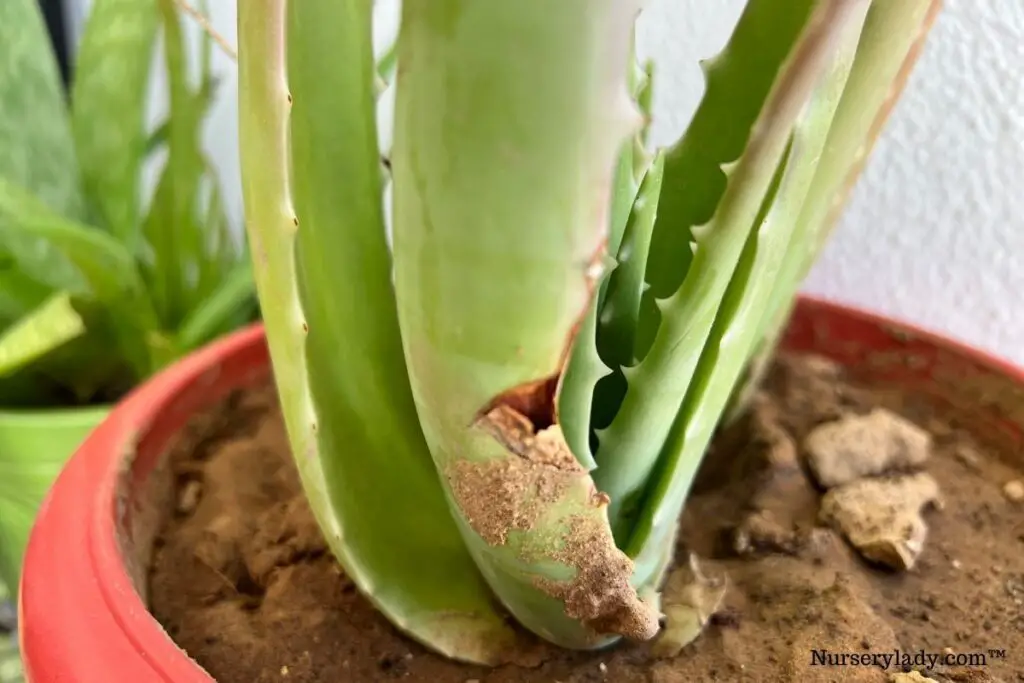
Outdoor lighting conditions: Naturally, Aloe Vera plants grow in deserts under the full sun.
So, you can grow them in your garden without any trouble.
If they are outdoors, plant them in a zone where they can get at least 6 hours of direct sunlight.
Also, make sure they receive some amount of shade during the mid-day and afternoon as the sun gets too scorching.
You can plant them in your garden’s south or west directions as these directions get the most sunlight.
The better, perfect natural light they receive, the more compact and fleshy they will grow.
However, sunburn is a matter of concern sometimes, especially during the hot summers.
The plant will get sunburned if you suddenly shift an indoor plant outdoors.
If you want them to get used to the outdoor sun, gradually acclimate and expose the plant outdoors to get enough time to adjust to the direct sun.
Indoor light conditions: Indoors, your aloe vera may experience low light conditions due to a lack of full sun.
To let them have adequate natural sunlight, place them near a south or west-facing window for 5-6 hours without any sheer curtains.
Bring them 3 feet back from the window.
After that, you can put on the sheer curtains to filter the scorching sun.
If you have kept them near the north or east-facing window, you need to increase the light conditions with artificial lights.
Keep a fluorescent lamp 1-2 feet above the plant for 12-14 hours during the day.
Putting the lamp on for 16 hours will give good results if the plant is in a shaded area indoors.
Looking for gardening supplies? We have tested 100's of products before recommending them to you guys. Check out our best pick below:
| Image | Gardening Supplies | Best Price? |
|---|---|---|
 Top
Top Top
Top | Raised Garden Bed Kit | Check On Amazon |
 | XLUX Soil Moisture Meter, Plant Water Monitor, Soil Hygrometer Sensor for Gardening, Farming, Indoor and Outdoor Plants, No Batteries Required | No Results |
 Top
Top Top
Top | 82 Pcs Garden Tools Set and Extra Succulent Tools Set | Check On Amazon |
 | Joeys Garden Expandable Garden Hose with 8 Function Hose Nozzle, Lightweight Anti-Kink Flexible Garden Hoses, Extra Strength Fabric with Double Latex Core, (50 FT, Black) | No Results |
 Top
Top Top
Top | Dual Chamber Compost Tumbler | Check On Amazon |
 Top
Top Top
Top | Sunnyglade Plant Stakes | Check On Amazon |
 Top
Top Top
Top | Organic Cold Pressed Neem Seed Oil | Check On Amazon |
 Top
Top Top
Top | Mighty Mint Gallon :-Insect and Pest Control Peppermint Oil | Check On Amazon |
 Top
Top Top
Top | Scotts DiseaseEx Lawn Fungicide | Check On Amazon |
 Top
Top Top
Top | Jacks Classic 20-20-20 All Purpose Fertilizer | Check On Amazon |
 Top
Top Top
Top | 30,000 Seeds Pollinator Attracting Wildflower Mixture | Check On Amazon |
 Top
Top Top
Top | Survival Vegetable Seeds Garden Kit-Over 16,000 Seeds | Check On Amazon |
Light requirements according to their age
The old plants require and can tolerate direct sunlight more than the young ones.
If you have recently propagated the Aloe Vera plants, let them have filtered sunlight.
You can keep them near the north or east-facing windows without additional lights.
If they are near south or west-facing windows, put on sheer curtains to filter the intense direct sunlight.
If the plants are outdoors, put on shading nets or transparent clothes to filter the light.
Never expose them to the mid-day or afternoon sunlight.
Once they get well-established, gradually expose them to direct sunlight.
Summer vs. winter light requirements
In the summers, let Aloe Vera receive direct sunlight in the morning.
During the mid-day and afternoon, the sun becomes scorching.
So it would help if you protected them.
For outdoor plants, use shading clothes.
For indoor plants, use sheer curtains on the south or west-facing windows.
Though they are sun-loving plants, they too can get sunburned under such scorching sunlight.
If your region is moderately cold during winters, you can keep them outside.
Remove the shade or curtains you have used to filter the light.
Expose them to direct sunlight.
As the sun intensity is quite low in the winters, direct sunlight will not harm them.
Rather it can maintain their growth rate and keep them relatively warm.
Will Aloe Vera plants tolerate full sun?
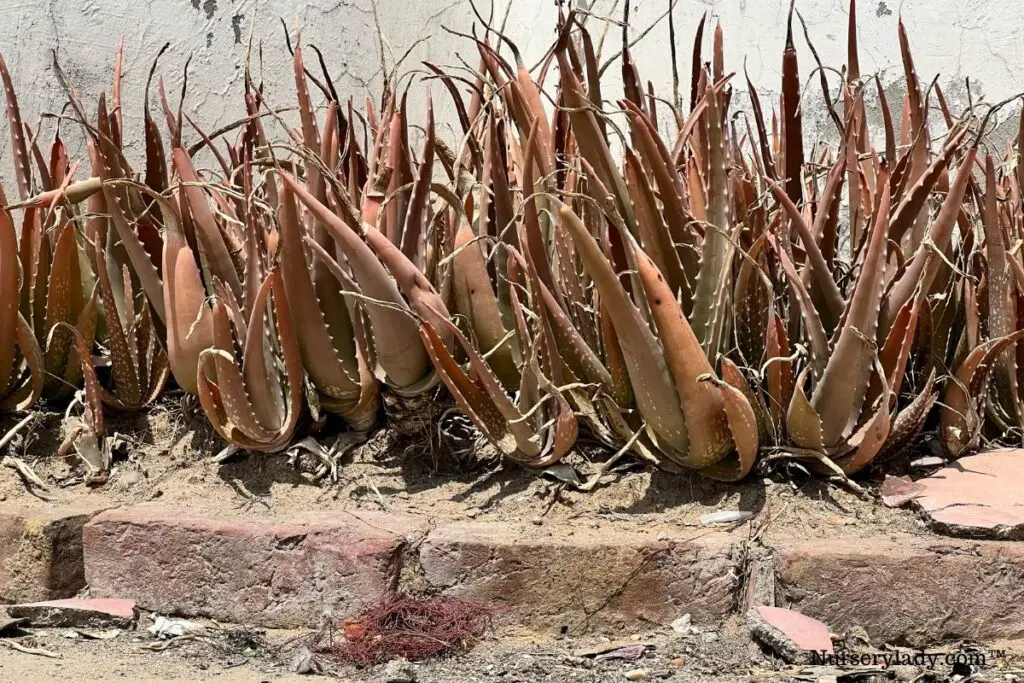
Being desert plants, Aloe Vera plants require a lot of sunlight.
A minimum of 6 hours of daily sunlight is essential for their health and color.
Aloe Vera plant is a tropical plant belonging to Africa, Madagascar, Jordan, and other islands on the Indian Ocean like Mauritius and Comoros.
They are hardy plants bearing desert origins.
That is why they can handle full sun.
It makes them feel that they are still growing in their natural habitat.
This feeling will keep them healthy, juicy, and colorful.
So, if you want Aloe Vera plants to stay healthy, at least 6 hours of sunlight is a must.
Can aloe vera get too much sun?
Aloe vera’s love for sunlight doesn’t mean they won’t get sunburn.
Sunburn happens mainly during the summers when you keep them outside under the scorching sun.
Outdoor aloe veras experience sunburn most often.
If your region is in the coastal areas or receives cool microclimates, excessive sunlight harm is rare.
However, it will still happen if Aloe Vera plants are grown against a wall in a south or west direction.
The sunlight can reflect and reach the plant.
Another situation when the Aloe Vera plants get sunburns is when you suddenly shift them from indoor to outdoor.
After growing under a controlled light condition for a long time, they will be unable to handle sudden changes in their light conditions and thus experience sunburn.
Signs of too much light:
- Wilting despite proper watering.
- Blanched leaves
- Leaves turning brown
How to solve it?
- Bring the aloe vera some feet back if it is too close to the south or west-facing window.
- Along with that, put on sheer curtains if the sunlight feels too intense.
- Shift potted plants to a partially shady area.
- For outdoor plants, put on shading clothes.
- If they grow in high light conditions, you can feed them averagely with 1/4th teaspoon of balanced fertilizer.
- Water your aloe vera well to keep it cool and hydrated. It can keep the plant from sunburn to some extent. Always provide water in the morning and not in the mid-day or afternoon.
Will Aloe Vera survive without sunlight?
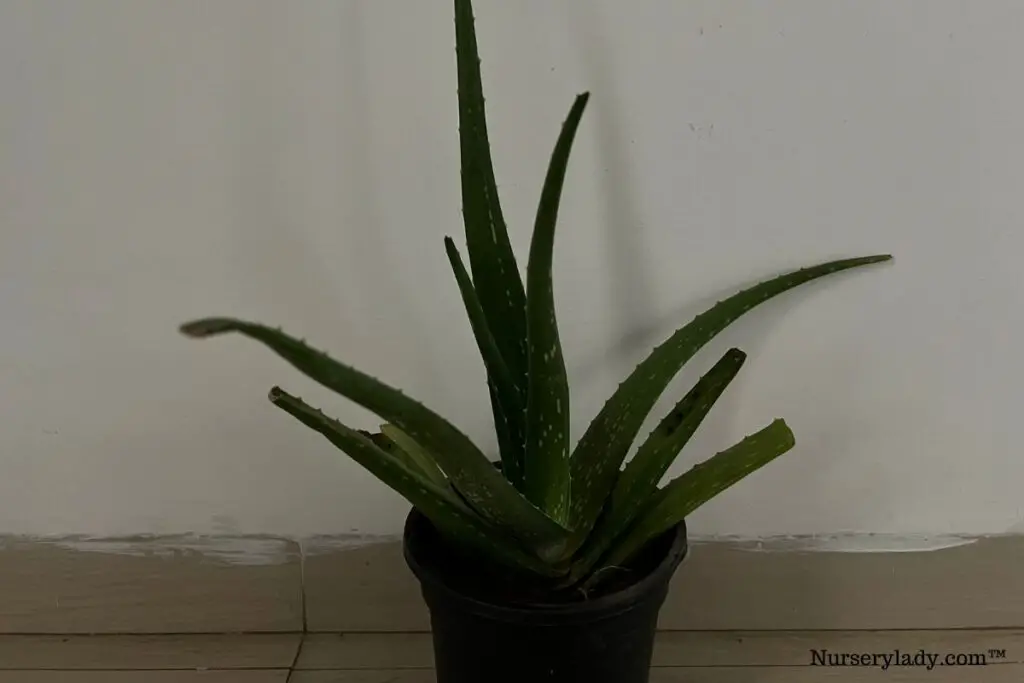
Since Aloe Vera are desert plants, they will require sunlight daily for good growth.
Without sunlight, they cannot stay healthy for long.
If you reside in a low sunlight region or your home doesn’t get enough sunlight, you can still keep the plant healthy by taking some steps.
However, you don’t have to worry if your Aloe Vera plants are outdoors because they will get enough sunlight outside.
If any day is cloudy, you can remove the shading nets.
Aloe Vera can grow under low light conditions, but its development would be poor.
The leaves will become leggy, weak, and soft.
Though Aloe Vera can survive under the shade for some days or weeks, they will eventually require some hours of sunlight to develop their color, length, and growth.
Lack of adequate light or no sunlight can lead to:
- Slow and dull growth
- Leaves losing color
- No blooming
- Weak stems and leaves falling over
- The plant will die if they don’t get light for a lengthy period. Due to lack of light, the soil will stay damp for prolonged periods, and prolonged dampness can result in root rot.
Can I fulfill Aloe vera’s lighting needs with artificial lights?
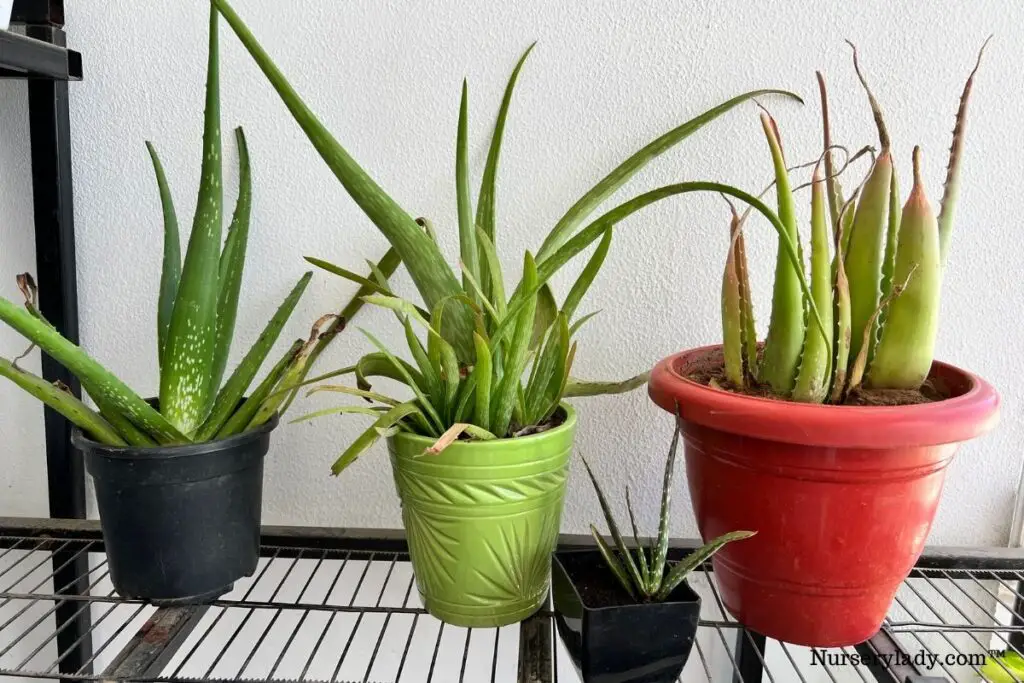
The Aloe Vera plant is a very bright plant that grows upward.
Their branches are thick, and the leaves are lance-shaped.
A long fluorescent light can work for them.
It will even be useful if you have too many plants in one place.
They can grow under LED plant spotlights indoors during cold temperatures.
It will keep them safe and moderately warm.
You can also use small lights and regulate them for every individual plant if you want.
You can also try the lights that come with remote controls.
You can control the brightness, the color, and the time they require to stay on.
There are lots of lights available in the market, and each of them has individual features which serve diverse purposes.
You must choose the one that seems suitable for your plant.
You can see results within a month.
The brightness of the S1200 series artificial light will be good for them.
These lights contain a red and blue spectrum needed for the proper functioning of photosynthesis.
It will also solve the issues related to high energy absorption and low light.
Keep the light on for 12-14 hours, along with 3-5 hours of natural light.
You can also keep it on for 16 hours if they receive limited sunlight.
Also, take care of the soil conditions.
Since the soil takes a lot of time to dry out under low light conditions, water them only after checking the soil moisture.
If the top 2 inches of the soil feel bone-dry, you can give them water.
Some hours of natural light is mandatory if you want your Aloe Vera plants to stay healthy and big.
Only grow lights won’t be able to fulfill their light requirements.
Can I take Aloe vera outside to give them adequate light?
Many people grow them indoors, and despite trying to give them adequate light, they show signs of low light conditions.
So in such cases, they think of putting them outdoors.
If you think of doing the same thing to give them adequate light, you must do it gradually.
You can put them outdoors, but you must check for a partially shady area, like under a tree or at a location where they won’t receive the hard sunlight of the noon.
Otherwise, it can cause sunburn.
Acclimate them slowly to the outdoor conditions.
After acclimating them, keep them at a location in your garden where they receive at least 5 hours of sunlight.
If the zone receives sunlight all day, put on shading nets after 11 am to 12 noon.
While taking them outdoors, ensure that the temperature stays above 65°F and not less than 50°F outdoors.
A good amount of light will keep the plant healthy from spring to summer at such temperatures.
Also, take care of the watering because the heat can make the soil dry out faster.
How to ensure the good health of my Aloe Vera plant?
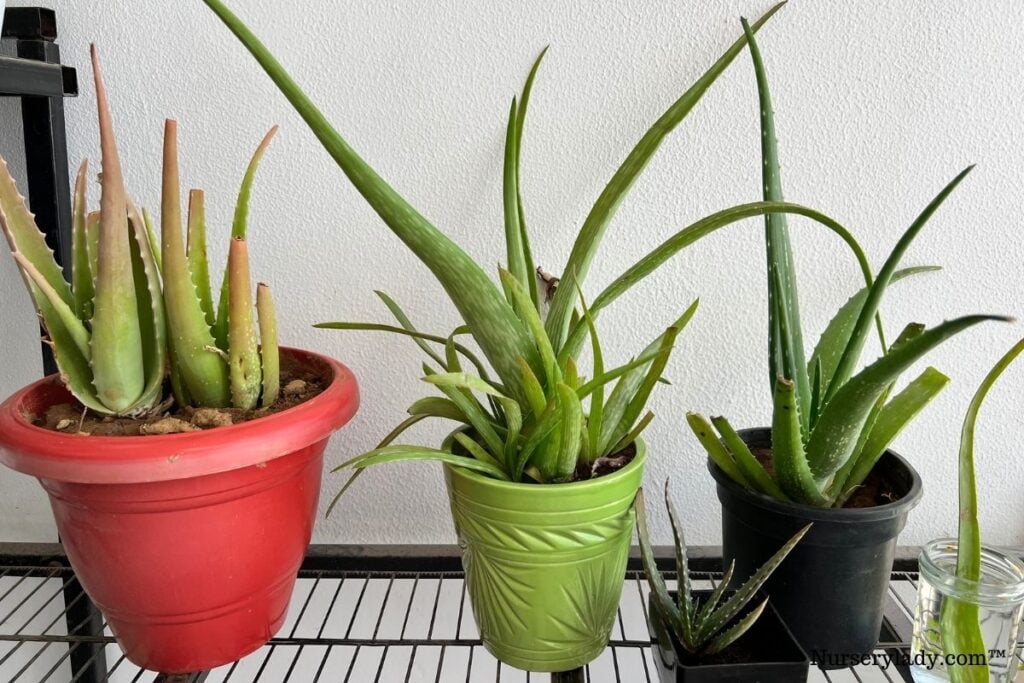
Growing Aloe Vera plants with care and attention are easy.
If you follow a few care tips, your Aloe Vera plants will stay healthy under proper sunlight.
| Factors | Care Tips |
|---|---|
| Light | Place them under direct or indirect light. I have not mentioned it before. But, Aloe Vera’s light requirements can also depend on the particular species. Some of them enjoy direct sunlight, and some enjoy indirect light. So, you have to experiment with them to know which condition is favorable. You can keep them in filtered sunlight, but at least 5-6 hours of daily sunlight can keep them healthy and large. Filtered light is good if you want them to stay compact, reducing their growth and water demand. |
| Drainage | The potted Aloe Vera plant must contain drainage holes in the containers for adequate drainage. For outdoor plants, ensure soil drainage. |
| Watering | Water them by checking the moisture level of the soil frequently. Due to direct sunlight, the heat can dry out the soil faster. |
| Fertilizing | You can also feed them slightly to keep them healthy under the high light conditions. |
| Weather | Safeguard the Aloe Vera plans from frosty weather. As they belong to warm regions, cold temperature is not their thing. Bring them indoors and keep them under grow lights to fulfill their light requirements. |
Final words
Caring for Aloe Vera plants is not so difficult. By providing sufficient sunlight, your Aloe Vera plants will stay healthy, and they will remain green, broad, and grow faster with adequate light.
You should provide direct sunlight to Aloe Vera plants only for 5-6 hours. They will require protection when the sunlight intensifies during the mid-day and afternoon.
At that time, you can provide them with filtered sunlight by putting on sheer curtains (for indoor plants) or shading clothes (for outdoor plants).
Reference: NCBI, New York Botanical Garden, University of New Hampshire, University of Florida, Wikipedia.

Your point of view caught my eye and was very interesting. Thanks